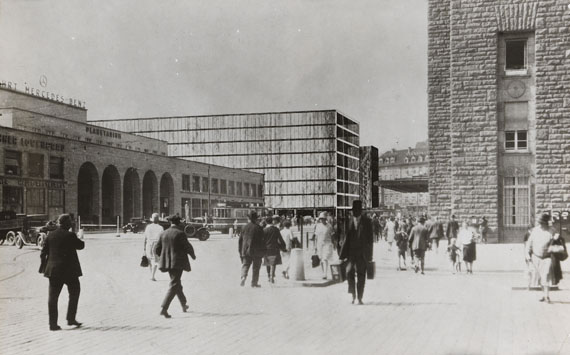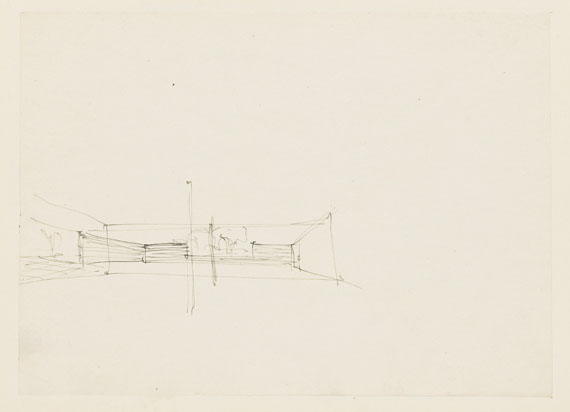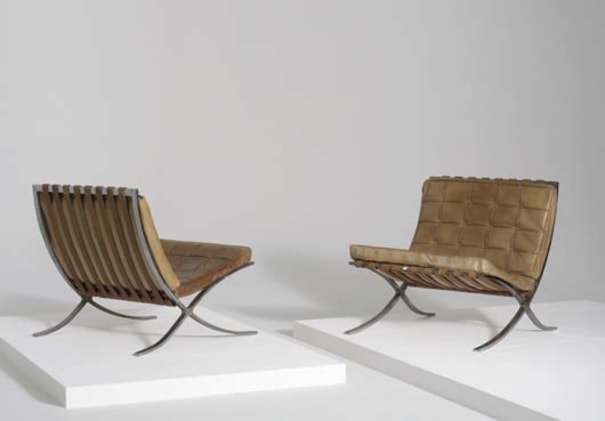Ludwig Mies van der Rohe Two rare and important lounge chairs, model nos. MR30 and MR40 ca. 1931 Nickel-plated tubular steel, woven cane. Each: 31 3/4 in. (80.6 cm) high Each probably manufactured by Bamberg Metallwerkstätten, Germany. Each with original caning by Lily Reich. Underside of armchair with paper labels “THEO GARVE” and “ERDAGAR/Hamberg” and indecipherable letters and underside of side chair with paper label “ERDAGAR/Hamberg” and indecipherable letters (2).
Provenance Estate of Theo Garve, Germany Exhibited Building Exhibition, Berlin, 1931 Literature Ludwig Glaeser, Ludwig Mies van der Rohe New York, 1977, pp. 112, fig. 20 for the side chair and p. 29 for a similar example of the armchair; Mies van der rohe: Furniture and buildings in Stuttgart, Barcelona, Brno, exh. cat., Vitra Design Museum, Weil am Rhein, 1998, p. 32 for the side chair and p. 35 for the armchair Catalogue Essay Theo Garve was a student of Max Beckmann and later became the chairman of Max Beckmann Gesellschaft. The offered lounge chairs and following console were part of the Building Exhibition in Berlin in 1931, an exposition conceived to display the latest developments in architecture, city planning and construction materials. Under the direction of Ludwig Mies van der Rohe and the interior designer Lilly Reich the exhibition contained a section entitled The Dwelling of Our Time which consisted of a series of full-scale houses, segments of buildings and interiors of apartments focusing on life in Berlin, and showcasing what came to be known as the “International Style” of architecture. The placement of Mies van der Rohe’s furniture designs within each setting allowed for visitors to see the new style of architecture and furniture design in practical use, and to envision their future within it. This was particularly poignant as the Building Exhibition took place at a time when Berlin was experiencing an economic depression as well as political chaos and focus on the future was most necessary. In Mies van der Rohe’s own words, “The Dwelling of Our Time does not yet exist. But changed living conditions demand its realization.” The concept of the Building Exhibition was so pivotal in the modernist movement that Die Form, the Werkbund journal, devoted most of its following two issues to the show. It was the Building Exhibition of 1931 that led to Mies van der Rohe signing a contract with Thonet-Mundus for the exclusive rights to 15 of his now famous chair designs. Read More
Ludwig Mies van der Rohe Two rare and important lounge chairs, model nos. MR30 and MR40 ca. 1931 Nickel-plated tubular steel, woven cane. Each: 31 3/4 in. (80.6 cm) high Each probably manufactured by Bamberg Metallwerkstätten, Germany. Each with original caning by Lily Reich. Underside of armchair with paper labels “THEO GARVE” and “ERDAGAR/Hamberg” and indecipherable letters and underside of side chair with paper label “ERDAGAR/Hamberg” and indecipherable letters (2).
Provenance Estate of Theo Garve, Germany Exhibited Building Exhibition, Berlin, 1931 Literature Ludwig Glaeser, Ludwig Mies van der Rohe New York, 1977, pp. 112, fig. 20 for the side chair and p. 29 for a similar example of the armchair; Mies van der rohe: Furniture and buildings in Stuttgart, Barcelona, Brno, exh. cat., Vitra Design Museum, Weil am Rhein, 1998, p. 32 for the side chair and p. 35 for the armchair Catalogue Essay Theo Garve was a student of Max Beckmann and later became the chairman of Max Beckmann Gesellschaft. The offered lounge chairs and following console were part of the Building Exhibition in Berlin in 1931, an exposition conceived to display the latest developments in architecture, city planning and construction materials. Under the direction of Ludwig Mies van der Rohe and the interior designer Lilly Reich the exhibition contained a section entitled The Dwelling of Our Time which consisted of a series of full-scale houses, segments of buildings and interiors of apartments focusing on life in Berlin, and showcasing what came to be known as the “International Style” of architecture. The placement of Mies van der Rohe’s furniture designs within each setting allowed for visitors to see the new style of architecture and furniture design in practical use, and to envision their future within it. This was particularly poignant as the Building Exhibition took place at a time when Berlin was experiencing an economic depression as well as political chaos and focus on the future was most necessary. In Mies van der Rohe’s own words, “The Dwelling of Our Time does not yet exist. But changed living conditions demand its realization.” The concept of the Building Exhibition was so pivotal in the modernist movement that Die Form, the Werkbund journal, devoted most of its following two issues to the show. It was the Building Exhibition of 1931 that led to Mies van der Rohe signing a contract with Thonet-Mundus for the exclusive rights to 15 of his now famous chair designs. Read More











Testen Sie LotSearch und seine Premium-Features 7 Tage - ohne Kosten!
Lassen Sie sich automatisch über neue Objekte in kommenden Auktionen benachrichtigen.
Suchauftrag anlegen